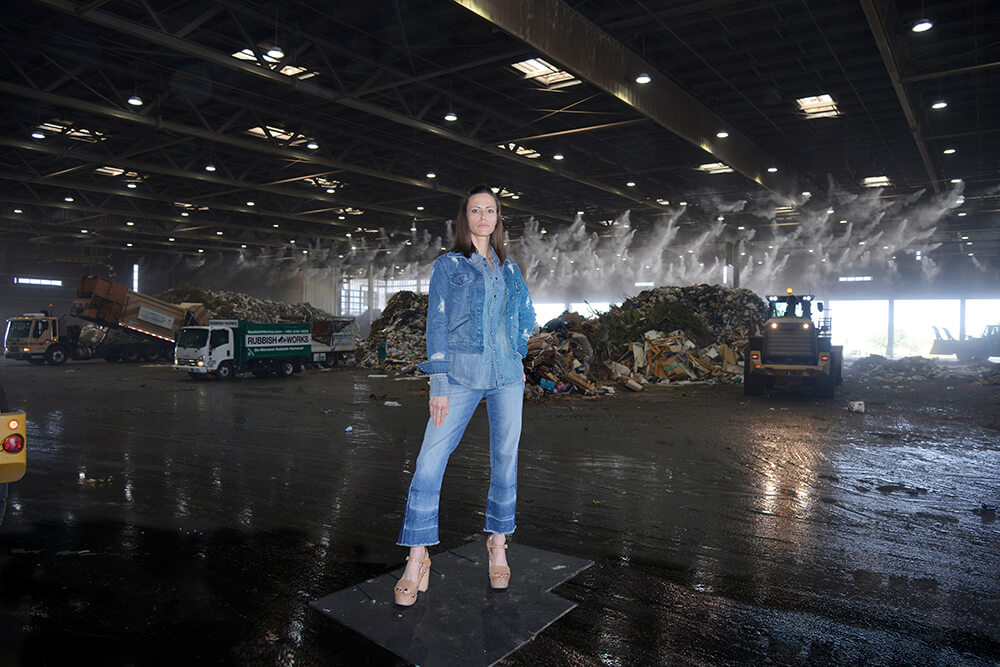
By Laura Madden.
Denim jeans are an iconic American style, referring back to classic Ralph Lauren ads, Brooke Shields in her Calvins, cowboys, and that California cool effortless vibe. What other garment could be more American than denim jeans? After all, jeans were originally created to clothe the laborers of the Gold Rush era because of denim’s durability. Shortly thereafter, they were made a wardrobe staple by Levi Strauss & Co. when the company became the first mass manufacturer of jeans. Unfortunately, there are a few cracks in this American success story. In fact, most of our jeans are not very American at all. According to Fashion Revolution, one-third of the jeans purchased in the U.S. come from China, which produces 260-300 million pairs per year.
Denim jeans are one of the most polluting garments in any wardrobe. And as the demand for denim continues to rise, so does the drain on the environment’s resources. According to the Environmental Protection Agency, it takes approximately 2,900 gallons of water to produce one pair of traditional cotton jeans. Just to give you an idea of the products and resources (fuel, water, dyes, pesticides, human labor, etc.) that go into the making of a pair of denim jeans, here is the CliffNotes version of the process.
- Cotton is grown
- Fabric is milled
- Fabric is dyed
- Pattern is cut
- Jeans are re-dyed
- Jeans are washed several times to make them softer, reduce shrinkage, prevent bleeding dyes, and to provide a “worn” look
- Oftentimes jeans are artificially distressed, which traditionally requires copious amounts of toxic chemicals, such as acids
Solutions for Wearing Denim Responsibly
This is not about guilting you into forever giving up your denim. Creating a cleaner, more sustainable planet doesn’t have to require suffering and sacrificing. I want you to have your denim and wear it too (wink). Where to start?
- Buy secondhand. Since the resources have already been used, you are extending the lifecycle of existing denim, and strengthening the circular economy by sourcing these items. (e.g., outfit shown from My Sister’s Closet, Scottsdale, AZ)
- Look for transparency. Look for brands that share specific details about their manufacturing and supply chain processes. Labels like sustainable, ethical, or eco aren’t enough. Brands should disclose how they’re doing what they say they are doing.
- Choose green materials. Organic cotton is better than conventional, but cotton is still one of the most water-dependent crops grown today. Alternative fibers such as Tencel (sourced from Eucalyptus trees) use 85 percent less water than cotton to produce.
- Shop for recycled denim. Recycled, upcycled, deadstock, vintage denim – essentially repurposing and redesigning denim from previously owned denim garments that have been discarded – is a green choice.
- Shop local. Look for brands that produce their denim jeans as close to home as possible; huge amounts of resources are saved in shipping.
Denim Care to Extend the Life of Your Jeans
Your denim’s sustainability journey doesn’t stop there. How you care for your denim matters, no matter where you’ve purchased it. Denim is extremely resilient and doesn’t need regular washing. According to sustainability expert and fashion designer Tracey Martin, you can wear your denim up to 10 times before washing. Instead, in between wears freeze garments in a bag to kill bacteria and remove odors.
Lastly, forgo the dryer, which is extremely damaging to your clothes, can break down fibers quickly, misshape them, and prematurely fade the color. Follow these simple tips and you can do the most sustainable thing possible – help your clothes last longer.
Responsibly Made Denim Brands
Laura Madden is a fashion advocate, model, and creator of Laura Madden Lifestyle, a lifestyle brand and blog that inspires a life of style, sustainability and self-esteem. Visit laura-madden.com for sustainable shopping tips and her sustainable fashion trends.
Photo by Aaron Blackburn. Wearing head-to-toe secondhand denim styled by Tess Loo and sourced from My Sister’s Closet, with locations in Chandler, Scottsdale and Phoenix.






